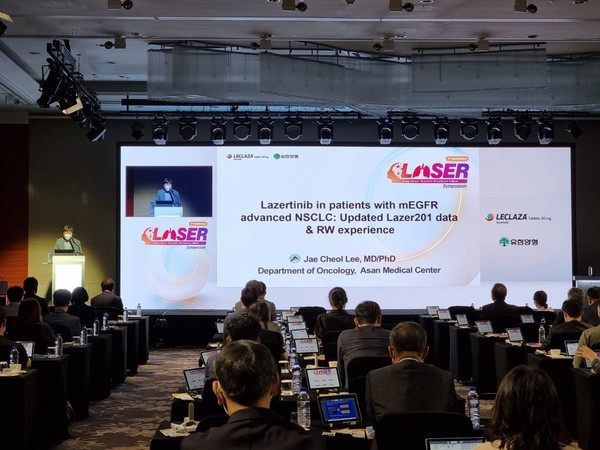Korean doctors are giving favorable reviews on Leclaza (lazertinib), the nation’s 31st novel drug for non-small cell lung cancer (NSCLC).
Physicians shared the experience of prescribing Leclaza, which was released on the market a year ago, at a symposium hosted by Yuhan Corp., the drug developer, in Seoul on June 25.
They also raised expectations for the NSCLC treatment’s further benefit as first-line therapy.
Speakers at the event included Professor Lee Sung-yong of pulmonology at the Korea University Guro Hospital and Professor Lee Jae-cheol of oncology at Asan Medical Center (AMC).

Professor Lee Sung-yong introduced studies of the third-generation epidermal growth factor receptor (EGFR) tyrosine kinase inhibitors (TKIs). He compared Leclaza with Tagrisso (osimertinib), a representative third-generation EGFR TKI.
He said the two treatments have almost identical targets and similar binding methods.
However, the two have different resistance mechanisms. While osimertinib shows more MET gene amplification, lazertinib activates PI3K signaling pathways more.
Adverse events of the two treatments include skin problems, but he added that lazertinib could uniquely cause paresthesia or an abnormal sensation or pain in the body.
Citing the latest data from phase 1/2 trials of lazertinib, Lee said lazertinib’s progression-free survival (PFS) was about one month longer than that of osimertinib in T790M mutated NSCLC.
Also, lazertinib’s median overall survival was 38.9 months vs. 26.8 months for osimertinib.

“In terms of numbers, lazertinib showed a little longer survival performance,” he said.
Professor Lee Jae-cheol released the 17 cases of patients for whom he had prescribed lazertinib for the past year.
He shared tips for managing paresthesia, an adverse reaction to lazerinib. He said he could control paresthesia sufficiently by using Cymbalta (duloxetine) and Lyrica (pregabalin), except for extremely rare cases.
“Lazertinib is demonstrating excellent effects. We have to see how it will work in the first-line therapy,” Lee of AMC said.
One person from the floor asked Lee which treatment physicians should choose for a T790M mutated NSCLC patient -- Tagrisso or Leclaza.
In response, Lee said, “I don't think there will be any major issues with which drug you choose.”
However, he noted that physicians should consider osimertinib’s cardiotoxicity problem (QTc) and lazertinib’s a little better effect in intracranial reaction.
He added that lazertinib would be a better choice if the patient has metastasis.
Professor Lee Kye-young at the Lung Cancer Center of Konkuk University Medical Center said 20 years have passed since the first-generation targeted drug for NSCLC was developed in 2002.
He noted that lung cancer treatments had made remarkable progress, but no drug can cure lung cancer yet.
“By the 30th anniversary of the development of the first targeted drug, I hope that Leclaza will have cured many EGFR mutated lung cancer patients,” he said.

